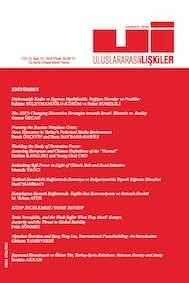
Uluslararası İlişkiler Dergisi
Yazarlar: Nur BİLGE-CRISS
Konular:-
Anahtar Kelimeler:Concert of Europe,19th Century Ottoman Foreign Policy,NATO and Turkey
Özet: This study offers a historical perspective on Turkey’s consistent policies to become a member of western political and security systems, both institutionally and legally, by utilizing the learning theory concept. Drawing lessons from the past as well as Turkey’s quest to place itself within the international system, takes the subject back to the 19th century. Consequently, when approached as a matter of belonging to a system from a historical perspective, a broader picture may shed new light on the question, “why NATO?” Another aim of the paper is to carry Turkey’s NATO membership beyond the confines of “Soviet threat”, “westernization”, and “ideological warfare” categories. It has been a consistent policy in Turkey to adapt to the world conjuncture/systems and eschew isolation. That this quest was fulfilled in mid 20th century by membership in NATO points to a long but consistent journey
Dergi editörleri editör girişini kullanarak sisteme giriş yapabilirler. Editör girişi için tıklayınız.